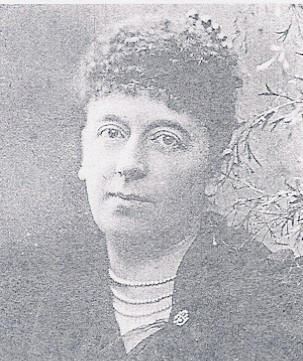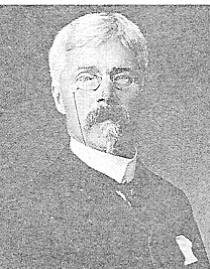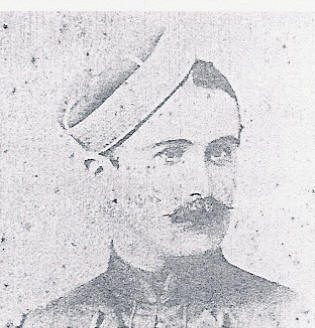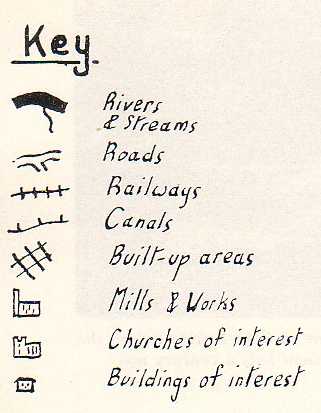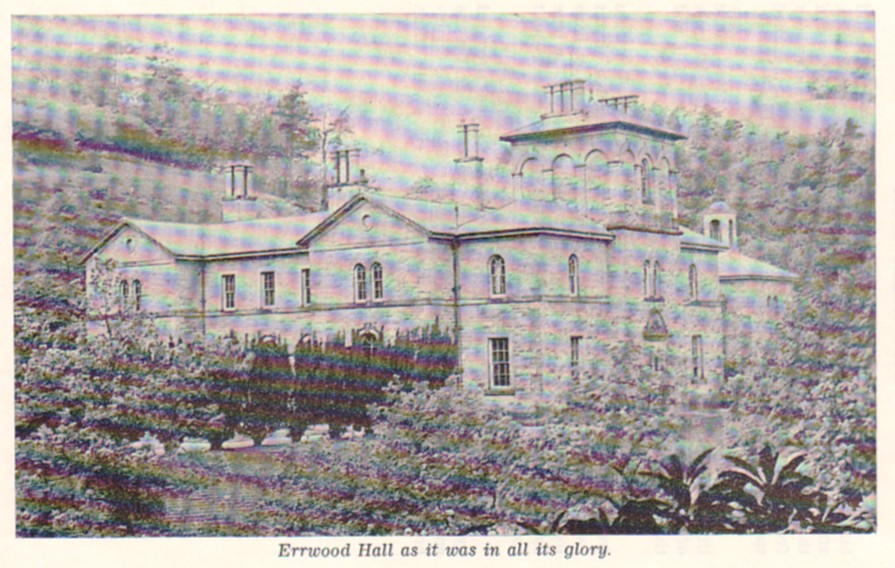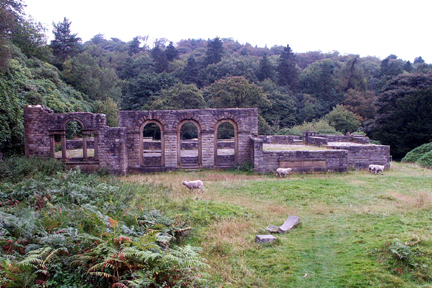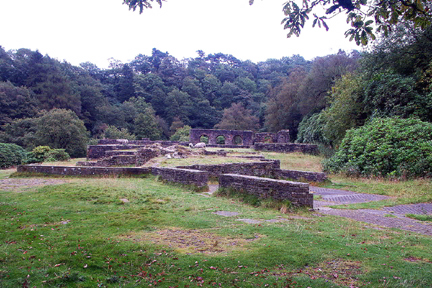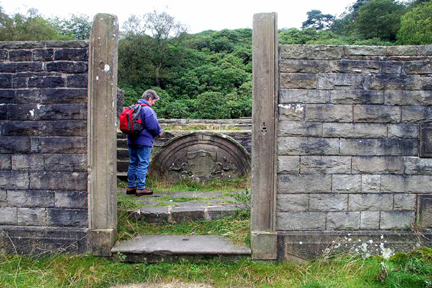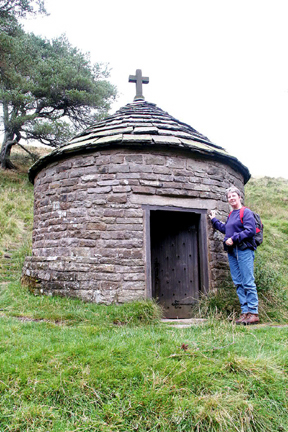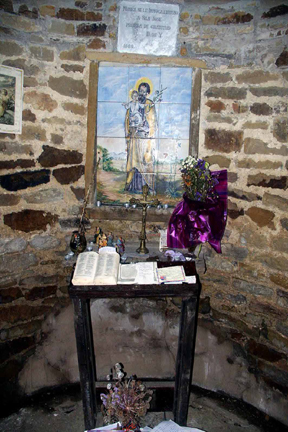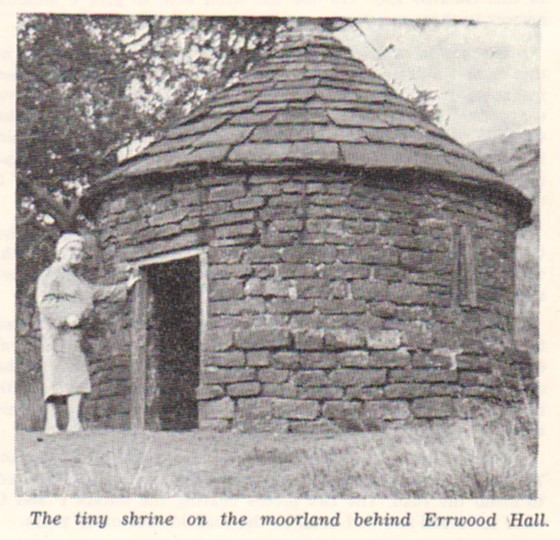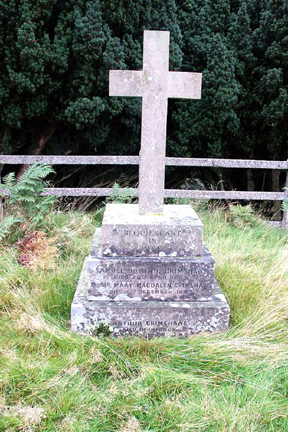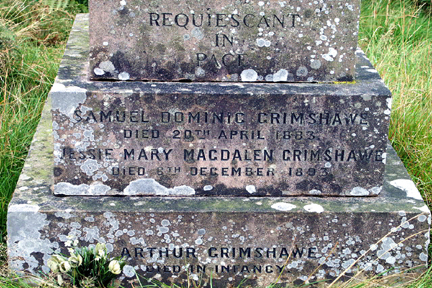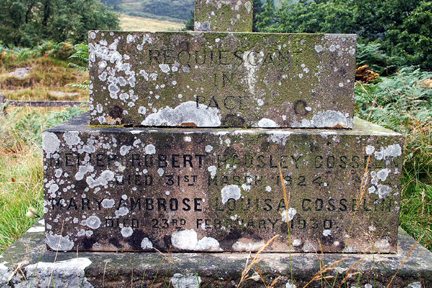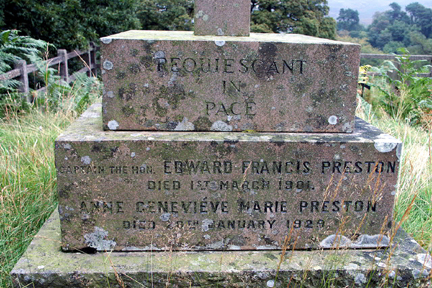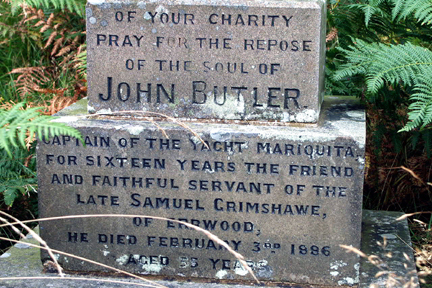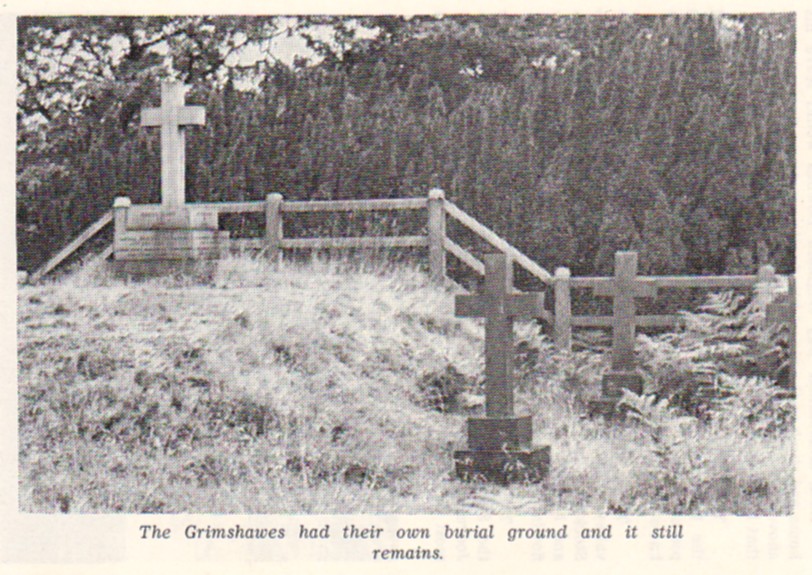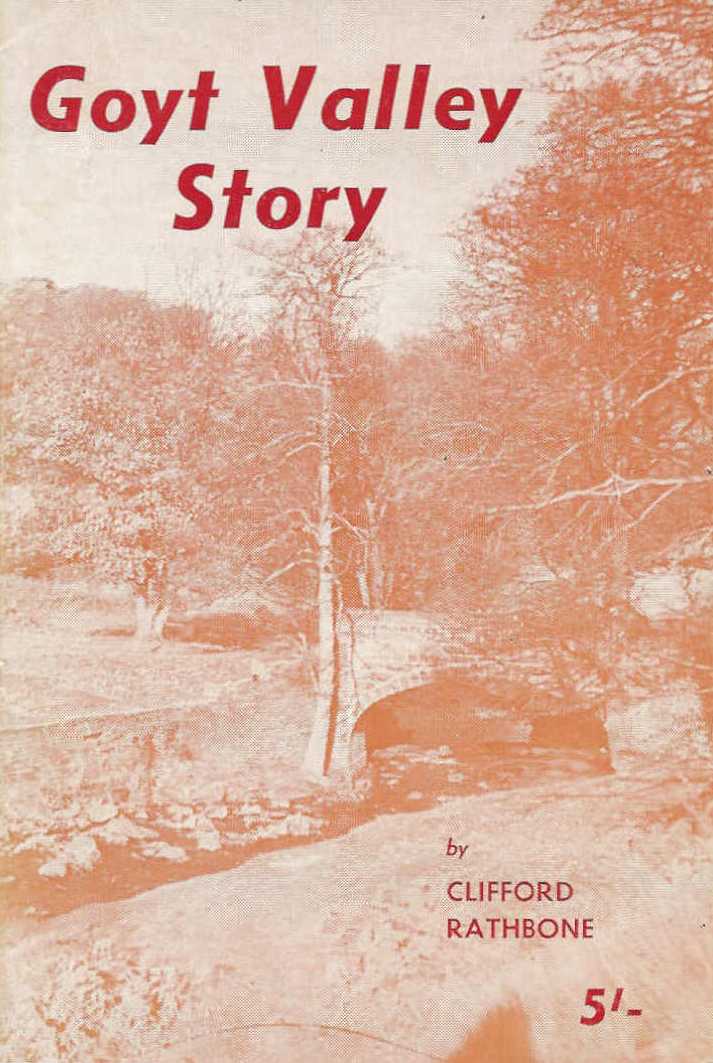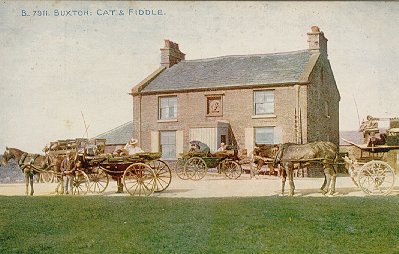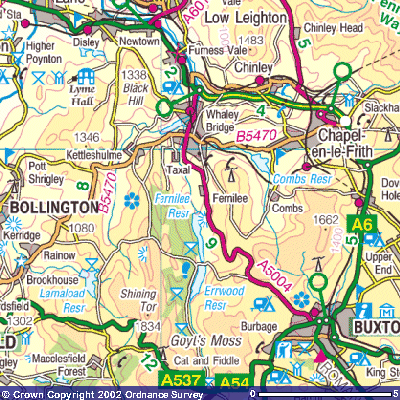The Grimshaws of Errwood Hall
Goyt Valley, Derbyshire

Errwood Hall
Errwood Hall is located in Goyt Valley, southeast of Manchester and not far from Buxton (see Figure 1 below). The hall was built in the mid-1800s by a wealthy Grimshawe family from Manchester and was occupied by descendants of the family until 1930. Samuel Grimshawe II (born 1811) built the hall, and the family enjoyed a rich and abundant life there (including extensive foreign travel in a family yacht). However, there were no descendants of the family after Samuels grandchildren with the Grimshawe surname. Errwood Hall was demolished in the 1930s in connection with construction of nearby Fernilee Reservoir, but the remains have been preserved and are now a popular stop for hikers.
Contents
Descendant Chart for Samuel and Anne (Hume) Grimshawe
Family History of the Errwood Hall Grimshawes
Errwood Hall – Yesterday and Today
Figure 1. Regional map showing location of Goyt Valley in relation to Manchester and Macclesfield. [Map taken from the following website — http://www.peakdistrict-education.gov.uk/Fact%20Sheets/fz20goyt.htm]
Website Credits
Thanks go to Colin Butterworth for researching the area around Errwood Hall and providing many excellent photos of the remains of Hall as they exist today. Credit is also given to Gerald Hancock for his extensive research on Errwood Hall and the Grimshawes who lived there. Visitors to this webpage are encouraged to go to his website (http://www.goytvalley.50megs.com) to learn more about his newest book, “Goyt Valley Romance”.
Descendant Chart for Samuel and Anne (Hume) Grimshawe
Samuel Grimshawe II, the builder of Errwood Hall, was the son of Samuel Grimshawe, a wealthy merchant in Manchester. Samuel (II) was married to Anne Hume; a chart of their descendants is shown in Figure 2
Figure 2. Descendant Chart for Samuel and Anne (Hume) Grimshawe
Samuel Grimshawe
|—Samuel Grimshawe (1768 – 27 Jan 1851) & Anne Hume ( – Jun 1850). Married 14 Apr 1869.
|—|—Samuel Dominic Grimshawe (1811, Manchester – 20 Apr 1883, Errwood) & Jessie Mary Magdalen Hunter ( – 7 Dec 1893). Married Jun 1849, Edinburgh
|—|—|—Samuel Arthur Hope Grimshawe (May 1850 – 4 Aug 1851)
|—|—|—Mary Ambrose Jemina Louisa Grimshawe (7 Dec 1851 – 23 Feb 1930) & Hellier Robert Hadsley Gosselin (1849 – 31 Mar 1924). Married 16 Jul 1902, London.
|—|—|—Anna Genevieve Marie Grimshawe (ca Dec 1852 – 28 Jan 1929) & Edward Francis John Preston (1845 – 1 Mar 1901). Married 1 Jan 1891, London.
|—|—Margaret Elizabeth Grimshawe & John Upton Gaskell. Married 1843, Taxall.
|—Unknown Daughter Grimshawe
|—Unknown Daughter Grimshawe
It is unknown if the family has been linked to the earlier lines of Grimshaws, but the presence of the “e” at the end of the name may indicate descent from Thomas Shuttleworth Grimshaw (see webpages on the Pendle Forest line of Grimshaws and on Thomas S. Grimshaw). Thomas was one of the earliest (and one of the few) Grimshaw families to add an “e” to the name. Hancock1 provides photos of Mary and Hellier Grimshaw (Figure 3) and of Edward Preston (Figure 4).
Figure 2. Mary (Grimshawe) Gosselin and her husband, Hellier Gosselin (from Hancock, p. 23.)
Figure 3. Captain Edward Francis John Preston, husband of Anna Genevieve (Grimshaw) Preston. (from Hancock, p. 22.)
Family History of the Errwood Hall Grimshawes
The story of the Errwood Hall Grimshawe family is well summarized by Hancock1 (p. 18-33) as shown below. As noted above, visitors to this webpage are encouraged to go to Mr. Hancock’s website (http://www.goytvalley.50megs.com) to learn more about the Grimshawes and Errwood Hall in his newest book, “Goyt Valley Romance”.
Samuel Grimshawe, (1768-1851) came from a rich merchanting family in Manchester. He was the son of a Manchester merchant of the same name (Samuel Grimshawe), and married to Anne the daughter of Otho Hume, a member of the Pitt Club. The son, Samuel a pupil of Manchester Grammar School, held the office of Borough Reeve, for which he was qualified by previous duty as Sidesman at the Collegiate Church and as a constable. In 1824 he was living in Mosely Street. He was the member of the important conservative Shawes Club, and his entry in the membership list of 1825 reads; Grimshawe Samuel, Millbank, at T. Heywoods, Old Quay. Merchant. Aged 55. Grammar School. Court Leet Juryman and Assessor. Sidesman. Natural History Society. Director of Manchester Assurance Company. Married with son and daughter. Samuel II, lived some twenty years in Mosely Street, while two of Samuels sisters lived in nearby George Street. It was about this time that Samuel Grimshawe went to live at Mill Bank, a house on the banks of the Mersey at Partington, which formed part of an old-established works and property, apparently acquired by the Grimshawes or the Hulmes. Before the mid-eighteenth century there had been a works there for slitting and rolling iron and when that gave way to a corn mill, a tariff arrangement was made with the Mersey and Irwell navigation, and the millers corn transport was tied to the Navigation for 1,000 years, so long as the river Mersey and Irwell shall remain navigable. There had been a paper mill here in the eighteenth century at Mill Bank. Samuel was on the Mersey and Irwell Navigation Committee and made considerable use of its facilities.
Old Quay was its terminus, though he still kept his house at Mosely Street. It was after 1835 that he began negotiations with John William Jodrell of Yeardsley Hall and purchased 2,064 acres of the Taxal Valley which included the Cat and Fiddlc inn. But Samuel Grimshawe was promptly met by a challenge from the Earl of Derby. His Lordship owned extensive lands in the adjoining Macclesfield Forest, and alleged that the Cat and Fiddle was on that side of the boundary, therefore on his land. Grimshawe would have none of it. He brought the old men of Taxal together before a Master Extraordinary in Chancery, and one Daniel Downes swore before the Master that he knew all about the boundaries. He was shown the boundaries as a young lad by a previous owner of the Taxal Moors, who had told him ‘I’ll show thee where the boundary goes, it may be of use to thee some time. Thou art a young lad.’ Dan’s recollections were too much for his Lordship of Derby and the Cat and Fiddle remained with the Grimshawes. Samuel Grimshawe II continued to live at Millbank, Partington, and still kept his house and business going there, while his son Samuel III was living with his mother and sister Margaret at the old Errwood Farm in 1841. They were probably living there while Errwood Hall was being built, with no doubt Samuel supervising the work.
Samuel, the younger, was born in Manchester in 1811 and after receiving an early private education, he entered Brasenose College, Oxford, at the age of eighteen. He graduated as a B.A. in 1830 and M.A. in 1833 and it was here he was influenced by John Henry Newman, eminent theologian, of Oriel College, who was a founder of the Oxford Movement.
The movement, also called the ‘Tractorian’ movement because of the large number of ‘Tracts’ wrote to the Times, advocating their cause. Other leaders were Henry Manning, John Keble, E.B. Pusey, and R.H. Fraude. Newman, Manning and others became life long friends and converted to Catholicism, but not yet Samuel Grimshawe.
In 1843, Samuel’s sister Margaret Elizabeth, was married at Taxal Parish Church to John Upton Gaskell of Ingersley Hall, near Bollington. The Gaskells were friends of the Grimshawes and fellow mill owners and indeed frequented the same Manchester club, ‘John Shaw’s’. Thomas Gaskell, John Upton’s father being president from 1824-1833. One of the mills at Ingersley Vale was said to have the second largest water wheel in the British Isles, fifty six feet in diameter and ten feet six inches across the buckets. It was a walk or fulling mill producing ‘Fustian’, a type of heavy corduroy cloth.
Samuel was married in Edinburgh in June 1849 as the marriage notice described in a Scottish newspaper:- ‘At 5, Hillside Crescent, on the 18th instant by the Right Rev. the Lord Bishop of Madras, Samuel Grimshawe Esq., only son of S. Grimshawe, Esq., of Errwood Hall and Mill Bank, Cheshire, to Jessie Hunter, eldest daughter of Alexander Allan, Esq.,’
The following few years were mixed with joy and sadness. Great joy of a son, Samuel Arthur Hope, born in May 1850, but marred in June of the same year of the death of Samuel’s mother Anne. She lies buried at Taxal Church where there is a plaque erected by Margaret Elizabeth Grimshawe the daughter, in memoriam to her parents, for her father, Samuel II died some seven months later, but is not buried at Taxal, as the plaque seems to suggest, but at St. Peter’s Church, Manchester.
Samuel II of Errwood Hall, Taxal, and Mill Bank, Manchester, died on the 27th January 1851. An extract from his will, made 13th December 1848, bequested to his son in law, John Upton Gaskell of Ingersley Hall, and his Manchester solicitor, the sum of £5,000 to be invested in government stock, bonds etc., in trust to the benefit of his wife Ann Grimshawe, the remainder to be divided between his son Samuel and daughter Margaret Elizabeth Gaskell. He also requested that his house and grounds at Mill Bank be kept up and maintained for his wife, with the remainder of the estate to his son Samuel III. However, since his wife’s death there was a codical to the will dated 2nd August 1840. ‘Whereas my wife Ann Grimshawe has since departed this life and I have since given my daughter Margaret Elizc1betll Gaskell the sum of £2,500, the bequests formerly made to them are hereby revoked. Furthermore my dwellinghouse, outbuildings, offices and premises in King Street, Manchester to go to my dal1ghter Margaret, in lieu of the £2,000 granted to her under her marriage settlement’. The estate valued at about £14,000 went to his son Samuel III.
The founder and builder of Errwood Hall at the age of 83 had now gone, but he had realised his ambition of a gentleman’s country seat, in probably one of the most romantic locations in Cheshire.
Hardly had the family overcome the passing of old Samuel than the young infant, Samuel Arthur Hope Grimshawe died at the age of fifteen months. He died on the 4th August 1851 at the Hall, the cause of death given as enteritis. One can only guess of the pain of such a tragic loss that must have been felt not only in the family, but throughout the whole of the Errwood estate. Errwood Hall, which in those early years lay just inside the boundary of Cheshire, was designed by Alexander Beresford Hope, (Hon. PRIBA 1829-87) who inherited Beresford Hall, Staffordshire from his kinsman, Field Marshall Viscount Beresford. It was one of this gifted amateurs earliest buildings, being built from c.1840. Beresford Hope, politician, ecclesiologist and amateur architect, (like his father Thomas) was chiefly remembered for building in Gothic, though Errwood was Italianate with Norman details. The Hall was a turreted, double winged structure of millstone grit sandstone, of some Italian style, with a central tower and a chapel, which formed the upper storey of an extension to the northern end. A French window opened onto a terraced garden at the southern end, with wide steps leading up to the main entrance. The Hall faced east towards Long Hill on the Buxton to Stockport road.
Over the front door was the crest of the Grimshawe’s, a dragon and a small coat of arms. In the garden stood a large ornamented stone arch surmounted by a bird and a large G, its remains now long gone, where it stood among the small fountain and flower beds. High in a window in the central tower there was always a crucifix with a lamp shilling before it. From here must have been the best view of all looking over the trees and down to Goyt’s Bridge.
By now in 1851, the Grimshawe family were well established at the Hall and had acquired nine servants. It was at this time that Samuel Grimshawe declared his conversion to Catholicism, and had the upper storey of the northern extension of the Hall made into a private Catholic Chapel. He was received into the Church as Samuel Dominic Grimshawe.
Dedicated to St. Mary, it was opened on the 8th October 1851 by the Bishop of the Diocese in the presence of about five hundred persons from Macclesfield and the neighbourhood. The Bishop, James Brown, was the first Catholic Bishop of Shrewsbury and he preached to the crowd in the open air. The first resident Chaplain at the Hall was Henry Allcock.
In the 1851 census Samuel Grimshawe gave his profession as ‘Land Proprietor’ and it is known that property was bought at this time in neighbouring Manchester and its suburbs. There are places in Levenshulme which bear history the Grimshawe name, ‘Errwood Road’ being just one. There is little doubt that they were indeed a very wealthy family.
On the 7th December 1851, Samuel and his wife Jessie were blessed with a daughter, Mary Ambrose Jemina Louisa, who was born at Errwood Hall. She was baptized at St. Albans Church, Macclesfield on the 2nd February 1851 by John Hall. The godfather was Rev. J. E. Manning and the godmother Lady Louisa Stewart.
One year later a second daughter was born, Anna Genevieve Marie, in Paris, when the family were on a visit to France.
By 1961 Samuel Grimshawe had become a County Magistrate for Derby and Chester, and was maintaining quite a sizeable cosmopolitan household. The daughters Mary and Genevieve, had their own young ladies maid and a German governess from Munich, while there was a French butler, several Irish maids, gardeners, and a Lancashire cook. There was also a visiting artist, W.H. Bower, who may have been involved in portrait work.
Samuel Grimshawe, became very generous to the Catholic Church, not least in the year 1860 when he gave £l00 towards the cost of St. Annes Church at Buxton. On the 9th February it is recorded Mr. & Mrs. Grimshawe subscribed £500 towards the cost of a new Church at Stockport. Then on the 4th August 1860, the laying of the foundation stone of St. Anne’s Church, Buxton, by Genevieve Grimshawe when seven years old. The health of Samuel Grimshawe and his family was proposed during the dinner that followed the ceremony, which was at Errwood Hall. At this time the Catholic Church was hard pressed for funds to maintain its services to a growing congregation, and the support of an eminent County Magistrate, with the wealth and position of Samuel Grimshawe, was no doubt most welcome.
The young Grimshawe daughters would have had a good education, for apart from the excellent governess, they were surrounded at Errwood Hall by an absolute wealth of books. It was Anthony Powell who said ‘books do furnish a room, and this was certainly the case here, books in the study, the upstairs sitting room and eleven more cupboards in other places. Volume after volume, from Lewis Carroll, Hans Christen Anderson to Bronte, Shakespeare and Ruskin, with many language books, especially Spanish, German, and French. There were lots of Charles Dickens with many of them first editions, in fact books on every subject. Travel books too were a great highlight of the library, the Nile, Africa, How I found Livingstone. Round the World, ‘Cook’s Voyages’ and many more.
In 1870 Samuel Grimshawe became the owner of the yacht ‘Mariquita’, an ocean sailing ship, perhaps he had developed a thirst for travel, or maybe he wished to broaden his horizons. There is little doubt this must have pleased his teenage daughters, who would have been eighteen and nineteen years old by this time.
They had already travelled previously to France as Samuel and brother in law, John Upton Gaskill had business interests in coal mining there, near Paris, indeed Genevieve Grimshawe was born there. So they were not strangers to overseas travel. In fact during 1871 they were on board the Mariquita, with Captain John Butler sailing on the Mediterranean, visiting Spain and Italy, leaving a skeleton staff at the Hall. They were after all, living during an age of travel, invention and famous people. There were musicians, composers, such as Grieg, Brahms, Offenbach, the writers and poets, Kipling and Browning in this great Victorian age. The family continued to travel and kept the yacht into the eighteen eighties, sometimes bringing back foreign servants to work at Errwood. As previously, mentioned in an earlier chapter, the Grimshawe family loved parties and to entertain, their guests, many of them titled. The following report from a local newspaper dated 6th September 1873, included a treat to their tenants:- Festival at Errwood Hall. On Wednesday the coming of age of the daughters of S. Grimshawe, Esq., of Errwood Hall was celebrated by giving a treat to all their tenants and others. Prizes were offered for the different games, such as donkey race, hurdle race, foot race and sack race. Also, a pig chase, the pig to become the property of the person lucky enough to catch it. After the sports a sumptuous spread was laid out in a marquee on the ground. Dancing was the principal attraction for the rest of the evening. This was a period on the estate, when they had shooting parties in the season, with many of them titled guests of the Grimshawes, so many guests that sometimes there was not enough room at the Hall, and some guests would stay the night at the gatehouse cottage.
Sadly, Samuel Dominic Grimshawe died at the Hall on the 20th April 1883, with the estate passing to his wife Jessie. There followed a very impressive Catholic burial at the private cemetery on the hill behind the Hall, with many of the Catholic clergymen in attendance; The Very Rev. Canon Sheenan, V.G., Manchester; Very Rev. Canons Frith, Walker, Allan, Callagher, Monsgrs Cresdell, V.G., and Kershaw, V.G.; Fathers Robinson, Allixis, Willibrood, Lawless, Allen, Butler (Friar Monastery, Haverstock Hill) , Bell, Browne, Singleton, Maurice, Stanton and Power, with two Sisters from Bon Secours Convent, followed by the chief mourners:- the widow of the deceased, leaning on her brother, Colonel Allan, the Misses Grimshawe, Miss Gaskill, Miss Munster, Mr. Killminister, Capt and Mrs Butler, Mr. J.P. Munster, Dr. Darwin, The Fern, Buxton; Dr. C. Bennett, Dr. Robertson, Rev. G. Robertson, Mrs Bennett, Mrs. Carter, Mr. & Mrs. Sawyer, Mr. Richett, Mr. J. Downes, Mr. Thompson, Miss Murphy, and others, followed by the tenantry and crowds of inhabitants from the neighbouring villages, who came to pay their last tribute of respect to their deceased friend and benefactor.
The Bishop of Shrewsbury conducted the service afterwards in the chapel at the Hall.
On the 21st January 1891, Genevieve at the age of thirty seven was married to Edward Francis John Preston, forty five years of age. The ceremony took place at the Oratory, Kensington, in London by the second Bishop of Shrewsbury, Edmund Knight. Genevieve at the time of marriage, was staying at the Grimshawe’s London home of 80, Queens Gate, Kensington. They later left for a honeymoon in the South of France.
Edward Francis Preston was a distinguished military gentleman, and came from a very distinguished family. He was the second son of the 13th Viscount Gormanston, born in 1845, Captain late of the 9th Lancers, Lieutenant Lancashire Yeomanry Hussars 1873-80, late A.D.C. to the Duke of Abercorn, D.L., J.P. co. Meath, J.P. co. Dublin. He was a member of St. Georges Yacht Club. The family seat of the Gormanston’s was Gormanston Castle, County Meath, Ireland. The marriage of Genevieve to Captain Preston brought a long association of the Preston family with Errwood Hall and they, with their children, were to visit the estate on many occasions.
Ten years after her husband, the death of Mrs. Jessie Grimshawe occurred on the 6th December 1893 in London. Her body was brought back to her beloved Errwood, where it lay in state according to the custom of the Catholic Church, until the time of the appointed funeral. The burial took place on Thursday 13th December, beside the remains of her husband Dominic in the private cemetery on the hill behind the Hall. It was attended by a great number of Catholic clergy and many people journeyed to Errwood to witness the solemn proceedings, and to express their sympathy.
The Grimshawes continued to help the Catholic Church, and it was they who bought the land at Whaley Bridge for the building of the ‘Sacred Heart’. The land was purchased from Mr. Jodrell for the sum of £500, and the grand opening of the Church took place in, September 1900. Their circle of friends included many eminent people of the time including Cardinal Vaughan, the third Archbishop of Westminster, formerly the Bishop of Salford, a lifelong friend of Samuel Dominic Grimshawe, and the Hon. Alan de Tatton Egerton, M.P., and Sir Charles and Lady Halle, all were influential ladies and gentlemen and friends of the Grimshawes who would have been frequent visitors to the Hall.
Other local friends were the Swindells at Bollington. They were mill owners there and employed many local people.
On the 16th July 1902, Mary Grimshawe, aged fifty one years, married Hellier Robert Hadsley Gosselin, fifty three years ,of Bengeo Hall, Hertford. They were married, like sister Genevieve, at the Brompton Oratory, Kensington in London by the Bishop of Shrewsbury. The bride was given away by her uncle, General Allan, and the best man was Mr. P. J . Lynch. There were two bridesmaids, Miss Esme Preston and Miss E. Gosselin, the latter the youngest daughter of Sir Martin Gosselin. The bride and bridegroom received many presents from their respective relatives, the Prestons, Gosselins, and from Lady Gormanston. There were also presents from the servants of both Errwood Hall, and Bengeo Hall. A recherche breakfast was laid at Ennismore Gardens, London, the Hon. Mrs Preston entertaining the guests, after which the bride and bridegroom left for the South of France to spend their honeymoon.
Hellier Robert Hadsley Gosselin was another distinguished gentleman, coming from a very distinguished family of Norman, French descent. He was the second son of M.H. Gosselin, J .P., of Ware Priory, Herts, by daughter of Admiral Sir John Marshall; born at Wallfield, Hertford in 1849 and educated at Haileybury College. J.P. for the county of Herts; a member of Herts. County Council; Alderman Hertford Boroulgh Council; 1897-98 and 1898-99; High Sheriff 1906; assumed the additional name of Grimshawe by Deed Poll, 1902. Admiral Thomas le Marchant Gosselin was Helier’s grandfather. the name Helier, incidently comes from St. Helier’s, Jersey, where some of the family had originated from. Mr. Gosselin-Grimshawe was a courteous unassuming, essentially quiet man, who had the regard of everyone who had the privilege to be in his company.
He had travelled round the world and to Iceland and was very interested in antiquarian research. From 1884 to 1902 he was secretary to Royal Archeological Institute. He kept up his office on the Hertford County Council until 1913, travelling to Bengeo Hall from Errwood by train. If someone was taken ill on the Errwood estate, Mr. Gosselin would show a keen interest and always pay a visit with his wife Mary. He was in return well respected, by the valley community. This was especially a happy place where children played, for as well as being their home, this was also their private playground. When the snows came, it was a season of great delight not only for the children, but for the young ladies and staff at the Hall, when sledging would take place on the hill behind Castedge. Everyone would join in, often .just leaving the housekeeper alone with the owners until the early hours, singing and shouting happily all night long, such a great event it was. Summertime brought lots of visitors to Errwood and after 1891 many of these were the Preston family with their children, some of whom came from Ireland. The family of Arthur James Preston and his wife Christina Maria Dundas came from Silverstream, co. Dublin. Their four daughters were visitors to the Hall, one of them, Ina Esme Hilda was to stay a very long time. She was the second of the four sisters, Antoinette Eileen Maude, the eldest, Hermione Kathleen Mary, and Marguerite Irene the youngest, and they were cousins to Capt. Edward Francis Preston, who married Genevieve. After Arthur James Preston died sadly in 1896, Esme, when she was about six years old, came to stay at Errwood after her mother was taken ill. Esme who at first was rather homesick had her sister Antoinette to stay with her for six months, but she did see her other sisters from time to time. Captain Preston and his wife Genevieve could not have children, so Esme became adopted though not legally. Always the favourite she was virtually brought up at Errwood and indeed spent most of her early life there.
It was a great shock and sadness that Captain Preston died on the 1st March 1901 at the early age of fifty six. He died while on a visit to Mentone, near Monte Carlo, France. He was extremely well liked by all who knew him. His body was brought home to Errwood, and his coffin borne by members of the family and farming tenants, to the private burial ground behind the Hall. There were many Catholic clergymen in attendance and the service was conducted by the Bishop of Shrewsbury.
Other branches of the Preston family to visit Errwood were the children and grandchildren of the 14th Viscount Gormanston, William Joseph Preston, G.C.M.G., J.P. and D.L. co. Dublin and J.P. cos. Caven and Meath, High Sheriff, Dublin 1865, and Meath 1871; Lieut. 60th Rifles; Gov, of Tasmaina 1893-1900. His second son was Richard Martin Peter, D.S.O. (1917), Lt. Col., and his children to visit the Hall were Ismay Elizabeth and Diana Mary Bruce. His third son was John Anthony Hubert, M.C., Cart. 3rd Bn. Royal Irish Regt; and his children were Penelope Sybil Mary, Georgina Ismay Mary, and their half sister Daphne Pringle. They were all visitors to Errwood into the 1920’s. Hubert Preston’s children came accompanied by their nurse from Ireland and were treated to trips out to the zoo and funfair at Belle View in Manchester at that time. There were trips out to the Cat and Fiddle on warm summer days for lemonade and picnics in the family’s coach and pair, and there were rides in the new motor car driven by Esme. Halcyon days affectionately recalled by surviving relatives.
The sudden death on the 31st March 1924 of Helier Gosselin, caused very deep regret, not only in the family and Errwood, but also at Hertford, from where he originated and had taken a keen interest in local affairs. As with all the members of the family, the funeral took place in the private cemetery, on the hill at the rear of the Hall after a service in the private chapel. The arrangements, at the Hall and the chapel were all carried out by the devoted servants, Ignatious Oyarzabal and his son Joseph and the service was conducted by the se Bishop of Shrewsbury, Hugh Singleton, with Father George Naylor preaching an eloquent sermon. Also present were Canon Kind, Buxton; Canon Roach, St Joseph’s, Stockport; Father Byne, Stockport; Father O’Reilly, Whaley Bridge; Canon High Welch, Altringham, and any other priests. Among the chief mourners were: Mrs. H. Gosselin, widow, Lady Gerard, Blakesware, Herts, Mrs. Medlicott, Wilts and Mrs. Smythe-Osbourne, nieces: Lady Gosselin, sister in law; Mr. Gerard Gosselin, brother; Hon. Mrs. Preston and Miss Preston; Dr. Arthur Shipton; Colonel Ramsden-Jodrell; Mrs Hubbersty; tenants on the estate, Errwood Hall servants and the servants at Bengeo Hall, Hertford. The bearers were all from the Errwood estate and included; Messrs. A. Warren, J. Clayton, H. Weir, B. Hibbert, J. Hibbert, J. Rock, E. Trueman, J. Hewitt, T. Jenkinson and J. Cottrill. Funeral arrangements were carried out by Mr. Peter Bennett, Torr Street, Buxton.
Both the Grimshawe sisters were now bereaved and ageing, but not quite alone for Esme was still there at Errwood and her sisters and other family members were frequent visitors to the estate. Reminding them perhaps of happy days of their winter holidays in Biaritze and the South of France, which Esme especially loved.
The days at Errwood were drawing to an end, but not so the memories and stories of their unending generosity. Of the tramps who passed through the grounds and had to be fed, or the postman who wasn’t allowed the journey back to Buxton without a good meal. The Grimshawe family are always remembered with an everlasting affection. One such story is of the large food parcel sent to the poor children of Whaley Bridge, of whom there were many in the late twenties. It was regularly delivered from an anonymous donor, but local people were very aware of the Grimshawes sisters generosity, and knew well of their kind hearts. They were often seen to travel, when weather permitted to Whaley Bridge or Buxton in the coach and pair which they always preferred to the motor car. Not for them the modern inventions of the wireless and telephone, for there were none at Errwood Hall. Perhaps motor cars would be rather alien to them, having grown up with l10rscs all their life that they knew and trusted. Almost always in their later years they were seen dressed in black lace on their trip through the wooded estate, more often bringing back large bags of sweets to the children at Errwood school.
Genevieve died on the 28th January 1929, buried alongside her husband, who was laid to rest some twenty eight years before on that windy outpost of the cemetery on the hilltop. Many of the Preston family travelled to Errwood to pay their last respects, along with many friends and Catholic priests in attendance. The service was conducted by the Bishop of Shrewesbury. Mary Gosselin-Grimshawe, without her devoted sister Genevieve, was now the last surviving. member of Samuel Grimshawe, family, alone with Esme and Antoinette Maud, who had returned to comfort her aunt.
In the cold November of 1929, Mary Gosselin asked one of her faithful servants, Mr. Heather, if he could organise a party of Roman Catholics to visit Errwood Hall for midnight mass. It was, she said, a long time since the little chapel was filled at Christmas. Some forty Roman Catholics attended the mass.
Mary Ambrose Louisa Gosselin-Grimshawe, (her full name) died the following year on the 23rd February 1930, and with her death went the glories of Errwood Hall. Joseph Oyarzabal, the trusted estate manager, made the arrangements at the chapel and the cemetery on the hill. A great number of people came to witness the last funeral at the private burial ground, and the service given by the Bishop of remainder to his son Joseph. She also left Ignatious £26 per annum during his life, and to Joseph £150. £50 to Ernest Grimes, the last priest in charge at Errwood Hall, £50 to her medical attendant, W. Shipton. £110 and a further sum of £l,000 to her devoted maid Mary Louise Billette, and £500 to her devoted friend Mme. Jeanie Waldejo, sister of her maid. The balance of £500 of the income to the Sisters of Charity Ancoats. £50 each to her servants Mary Brennan, Mary Lomas, Anne Jenkinson and Thomas Jenkinson, if in her service at her death in special recognition of their faithful service. £10 each to the priest in charge of the Catholic Church at Whaley Bridge, and the very Rev. Antonnius Maguire, O.P. St. Sebastions Priory, Pendleton, Manchester. £l00 to the Catholic Bishop of Salford, desiring without any trust that he will apply the income for the benefit of St. Mary’s Church, Clare Road, Levenshulme. £50 to the Convent, Clare Road, Levenshlume. £100 to the Bishop of Shrewsbury, that the income be used for the benefit of the Church at Whaley Bridge, The Sacred Heart. £100 to the Rev. Alexis O’Brian, of the Dominican Order of the St. Sebastions Priory, Gerald Road, Pendleton, Manchester.
Stockport Corporation purchased the estate in 1930 to build the Fernilee Reservoir and for a while Errwood Hall was used as a Youth Hostel, but in 1934 the Hall was dismantled for reasons of pollution along with the other thirteen farms and cottages on the estate. With the ravages of time, nature has reclaimed those serpentine walks through the terraced gardens that were harmonious with a Victorian elegance. A place where adventurous children played with delight in the silver brook, giving a warmth to an almost magical place.
The glorious blooms of the rhododendrons and azaleas, in the wooded splendor of Errwood, are visited by thousands each year, enjoying the walks around the ruins of the Hall. Where beauty lies broken and unrestored it becomes all the more attractive especially lying in such a romantic location. Lately the ruins have been consolidated, and are in the care of the Peak Park Authority.
Errwood Hall – Yesterday and Today
Rathbone2 prepared a short description of Goyt Valley, which includes an attractive sketch map of the valley and its principal landmarks (Figure 4). The map shows the location of Erwood Hall in relation to Whaley Bridge, Taxal, Cats Tor, Shining Tor and the Cat & Fiddle Inn.
Figure 4. Map of Goyt Valley showing location of Erwood Hall and other landmarks.
A good description of Errwood Hall and its design is provided by Hancock1 (from the text above) as follows:
Errwood Hall, which in those early years lay just inside the boundary of Cheshire, was designed by Alexander Beresford Hope, (Hon. PRIBA 1829-87) who inherited Beresford Hall, Staffordshire from his kinsman, Field Marshall Viscount Beresford. It was one of this gifted amateurs earliest buildings, being built from c.1840. Beresford Hope, politician, ecclesiologist and amateur architect, (like his father Thomas) was chiefly remembered for building in Gothic, though Errwood was Italianate with Norman details. The Hall was a turreted, double winged structure of millstone grit sandstone, of some Italian style, with a central tower and a chapel, which formed the upper storey of an extension to the northern end. A French window opened onto a terraced garden at the southern end, with wide steps leading up to the main entrance. The Hall faced east towards Long Hill on the Buxton to Stockport road.
Rathbone also provided a photo of the hall, which is shown in Figure 5. An image of the hall is also included at the top of this webpage.
Figure 5. Photo of Errwood Hall from Rathbone2. Date of photo unknown.
After Mary (Grimshaw) Gosselin, last of the Grimshaws, died in 1930, Errwood hall was sold. It was used as a youth hostel for a period of time, and later it was purchased by a water supply company in connection with construction of Fernilee Reservoir in the 1930s. As a precaution against potential pollution of the reservoir, the hall was demolished in 1934, although the floors and other remains were left in place. Figure 6 shows several views of these remains. A sign near the ruins provides the following background information:
“Errwood Hall
In front of you are the ruins of Errwood hall which was built about 1840 by Samuel Grimshawe, founder of family which dominated the life of the valley for nearly a century. The Grimshawes were a wealthy family who led a life of luxury. They were devout Catholics and had their own chapel and resident priest. Above the Hall is the family burial ground.
A staff of twenty were employed in the house and gardens and not far away, at Castedge, are the ruins of the servants’ cottages, the laundry, greenhouses and the vegetable garden. The Hall also had its own coal mine further up the valley which was worked until 1929. There was also a private school attended by about thirty local children and their teacher was Miss Dolores de Bergrin, a Spanish aristocrat, who died on a visit to Lourdes. The family built a shrine to her memory in 1889 on the moor below Foxlow Edge.
The Grimshawes were great travellers and boasted that there were 40,000 rhododendrons and azalea shrubs on the state, many of which were brought back from foreign lands as ballast for their yacht, The Marquita.
The last member of the family to live at Errwood was Mary Gosselin, Samuel Grimshawe’s granddaughter. After her death in 1930 the Hall was used for a short time as a youth hostel.
When Fernilee Reservoir was built in 1938 by Stockport Corporation, the Hall was demolished because of the fear of pollution and some of the building stone was used in the construction of the dam and the water treatment works at Fernilee.”
Thanks again go to Colin Butterworth for providing the following photos and the transcription of the sign.
Figure 6. Views of the Errwood Hall ruins as they appear today. Photos taken in September 2002 and provided courtesy of Colin Butterworth.
The Shrine to Miss Dolores
One of the people the Grimshawes met during their world travels in the family yacht apparently was “Miss Dolores”. As noted in the family history above, who was a member of Spanish nobility who returned to England with the Grimshawes and lived out her life there. No doubt because of the strong Roman Catholic faith of the family, a shrine was built in her memory a short distance behind Errwood Hall (Figures 7 and 8).
Figure 7. Exterior and interior views of the shrine to “Miss Dolores”, located near the ruins of Errwood Hall. Photos taken in September 2002 by Colin Butterworth.
Figure 8. Shrine to Miss Dolores as shown in Rathbone2.
Final Resting Places of the Errwood Hall Grimshawes
The Grimshawes had a private family cemetery at Errwood Hall. The graves of Samuel Dominic and Jessie Grimshaw and their three children – Samuel Arthur, Mary, and Anne Genevieve – as well as the spouses of Mary and Anne, are all in the cemetery (Figures 9 and 10). Also included are the graves of the former captain of the Grimshawe yacht, John Butler, and several of the servants of the family. The grave of Samuels father is at St. Peter’s Church in Manchester, and his mother is buried in a church cemetery in Taxal.
Figure 9. Photos of the Grimshawe family cemetery, with closeup views of Samuel Dominic and Jessie Grimshaw and their three children. Also shown is the grave of their yacht captain, John Butler. Photos taken September 2002 by Colin Butterworth.
Figure 10. The Grimshawe family cemetery as shown in Rathbone2.
Goyt Valley Story
The upper reaches of Goyt Valley, where Errwood Hall is located, is colorfully described by Rathbone2 as shown below (first two chapters). This description also includes several tidbits of information on the hall and on the Grimshaw family. A picture of Errwood reservoir is shown in Figure 11.
Figure 11. Errwood Reservoir, showing the moorland countryside of Goyt Valley. The view appears to be to the northeast.
GOYT VALLEY STORY.
CLIFFORD RATHBONE.
CHAPTER I
Many are the occasions I have walked through the valley of the River Goyt for the sole pleasure of taking in the beauty of the surroundings.
I have been at all times of the year. In winter when the snow has lain so deep that I have sunk into it well above my ankles at almost every step; in autumn when the bronzed L1oors rising precipitously from the stony bed of the river have shivered in the gentle breeze giving it a loveliness surpassing description, and then I have returned in summer to see the great transformation worked by nature. The greens of the bladelike ferns and the bilberry bushes are matched by the purple flowers of the heather.
It is the popular view that it is in summer that the valley looks its best. Personally, I can never quite make up my mind. To me there is something thrilling about the wild appearance it has in winter. But those are my own views.
This journey is being taken not merely for pleasure, although I have no doubt I shall have plenty. I am in search of knowledge; knowledge of the people who through the centuries have loved and worked in close proximity to the river. I am tracing the river from its source on the moors just below the Cat and Fiddle to where it joins the Mersey near to Stockport, and I hope to learn much.
Beyond Taxal it will be to me, a journey of adventure. When we in this part of the Country talk about Goyt Valley we refer to that part from the main Macclesfield-Buxton road over the old Errwood Estate to Taxal.
As you penetrate further into the valley new vistas open up. Parts of the valley have been dammed to provide a reservoir to meet the needs of Stockport, and work has already begun on a second reservoir. There are sections where the water is still used to keep the wheels of industry turning. There will be stories of tragedy and romance.
On the first stage of my journey I was fortunate in being accompanied by a charming lady of 76 years who lived for a great number of years on the Errwood Estate and received her early education at the small private school, now disappeared, which stood quite close to Goyt Bridge.
With her as my guide I was able to picture what that delightful area round about Errwood looked like when the Grimshawes were in residence at the Hall. The farms, the cottages, and most of the hall and private chapel have now been demolished, and all that remains to remind us of the days when Errwood was a happy and flourishing little community, practically self- contained, possessing even its own coalmine, are the ruins of the hall, and the rhododendrons, but more about that later.
I began my journey from the Cat and Fiddle Inn along the roadway which leaves the main thoroughfare to Buxton at a point about 100 yards on the Derbyshire side of the inn, but before doing so, I watched the holidaymakers, who had driven in their cars up to “The Cat” feeding the sheep.
Sheep are normally very timid animals, but in these parts they have become so accustomed to being fed by visitors that they will rush up to any car which stops by the roadside and beg for morsels like hungry dogs. I have even seen them enter the North Western bus after it has stopped at the Inn. They have become quite an attraction among the young people brought to this open moorland country by their parents.
The Cat and Fiddle Inn has the distinction of being the second highest Inn in England and stands 1,690 feet above sea level. It was built early in the 19th century by John Ryle, of Macclesfield, who was a banker in the house of Daintry and Ryle, in the days when there were so many private banking houses. Daintry and Ryle had premises on Park Green, Macclesfield. John Ryle acquired considerable wealth and in turn purchased the Henbury and Errwood estates.
The exact date of the building of the Cat and Fiddle is not known, but in 1831 it was described as “a newly erected and well accustomed inn or public house called and known as the cat and fiddle.” Many attempts have been made to explain the name of the inn. Local tradition used to state that the inn received its queer name from the fact that an early Duke of Devonshire used frequently to drive along the road and would stop at the summit to enjoy the view and pass half an hour playing upon his fiddle, to which instrument he was greatly devoted. Presumably he went to play on the moors because there he could annoy no-one but himself.
There are scores of other theories. By some it is said that it was named in honour of Catherine le Fidele, wife of Czar Peter the Great, while still another is that it merely indicates the game Cat (trap ball) and a fiddle for dancing, which is probably the true one. Over the main door of the inn is a carving of a cat playing a fiddle. But let us get on our journey.
At the beginning, the Goyt is just a thin silver streak forcing its way through the bracken and heather. “The turf’s like spring and the air’s like wine,” wrote Masefield. He J-1U~t have been at a spot like this when those words came to him.
The road along which I was walking down into the valley was the main road into Derbyshire before the top road into Buxton was cut. On the left are the foundations of the house which in years gone by was the stopping place for the coach before arriving in Burbage. The stepping-off stones which assisted the passengers to alight were removed only in recent years.
Just before I reached the bend in the roadway in the valley I came across the remains of two farms, Marchington Farm and Moss House. Moss Hall was a little lower down the road and on the opposite side. The last occupant of Moss Hall was a Mr. Peter Lomas. The moors hereabouts are riddled with old coalshafts, for at one time a considerable amount of coal was obtained from these parts.
The river gradually thickens out as it rolls over crags and rocks and is joined by the numerous riverlets from the higher ground. They find their way to the valley through crevices with the most charming names, such as Ravens Low, Foxhole Hollow, Deep Clough, Stake Clough, whilst one of the streams is known as Wildmoorstone Brook.
As the speed of the river increases, large boulders try to stem its progress, but all they have done is to create pools and waterfalls. The further I walked, the higher rose the ground on either side of the valley and on my right the purple-tipped heather covered a higher portion of the hillside. The road twists and turns as the scenery quickly changes.
On the left is an old gritstone quarry, flagstones from which were used to pave some of the London streets of the 18th century. They were carted all the way to London, via Leek.
According to Mr. Edward Bradbury, whose writings on the Derbyshire countryside were very popular towards the end of the last century, this quarry was first worked by members of the Pickford family, better known as the originators of the parcel vans. Close by there is a wide opening in the valley where formerly stood Goytsclough Mill.
I went to investigate this charming little spot. Water from the tiny stream which flows through Stake Clough over the moorlands was cascading over the rocks before racing along to fall into the Goyt. Years ago when the mill was standing, this water was used to drive the water wheel. There is now no sign of the mill, or of the three sturdily built cottages in which employees lived. The mill was last used for the making of paint.
It was at this point that my 76-year-old companion (to whom I promised not to divulge her name) commenced her story of the Valley of the Goyt, and a delightful story it is. I had arranged for her to be taken to the valley by car, although judging from the way in which she walked and climbed I have a feeling that she could have come on foot all the way from the Cat and Fiddle.
She could not remember the mill being worked, but she recalled the many occasions she had climbed the stone steps – which are still there – to watch the waterwheel. There were quite a number of farms and cottages in the valley in those days, and the people living in them thought nothing of walking from Macclesfield to Errwood and Goyt Bridge after they had done their shopping. My companion had many stories to relate. The glimmer of the candles providing the illumination in the cottages by the old mill would no doubt be welcome signs to the travellers in those days.
We made our way to Goyt Bridge and then up the three quarters of a mile drive to what remains of Errwood Hall, and all the time my companion was living over again the happy days of her youth among the small community whose homes were on the Errwood estate before a large portion of the valley was drowned to make the Fernilee Reservoir for the Stockport Corporation.
To prevent the danger of pollution, farms were closed and buildings demolished. Today this is a valley of happy memories, and as I walked through it I could imagine that the ghosts of those who had lived here in years gone by were walking about feeling not a little angry that the buildings which they had spent so much care in erecting had been pulled down.
Periodically my companion would pause and recall some little incident and I felt that she could see again the Mistress of Errwood driving in her coach and pair from the hall and through the valley, now under water, to Whaley.
The valley is at its prettiest at Goyt’s Bridge. A stream from Errwood joins the Goyt and the old stone bridge almost touching the water makes a grand picture, but it must have looked so much better years ago when on the bend in the lane by the entrance gates to Errwood stood the charming stone -built cottage with its well-stocked garden.
At the rear of the cottage was the private school provided by the Grimshawes for the children living on the estate. On the opposite side of the river were two farms, Goytshead and Goyts Bridge. The Hibberts lived at one, and the Ferns at the other.
CHAPTER II
Before beginning our long walk to the site of the old hall we stood for a while at Goyt’s Bridge, where my companion pictured for me the days of her childhood.
We talked of the time when she and her friends walked all the way from Macclesfield after they had been shopping in the town and of the days when the Truemans kept the Cat and Fiddle. During the shooting season there were dances in the tearooms by the side of the inn and employees of the Errwood Estate and their families were invited.
In the early hours of the morning the otherwise lonely road through the valley echoed the merry laughter of the young people as they returned to their homes.
The gate to the drive to Errwood is now bolted and barred and we climbed the stile by the side and set out on our journey of rediscovery. As once again my companion stepped on to the drive I thought I noticed her eyes sparkle. To her it must have been like going back home.
We had travelled only a few yards when she pointed out the spot on which formerly stood the private school. There were about 30 children attending at one time. It was then that I heard for the first time of Miss Dolores, a beautiful Spanish Lady of noble birth, who was the personal companion of old Mrs. Grimshawe towards the end of the last century.
Miss Dolores was greatly loved not only by the Grimshawes, but by young and old on the estate. She was a lady of culture and learning, but never had very good health and died in her middle forties when on a visit to the French town of Lourdes. It was in memory of her that the Grimshawes built the tiny shrine on the moorlands at the back of the hall.
Miss Dolores taught needlework and other subjects at the private school, and was helped by the wife of the gardener who lived at the nearby cottage, now demolished. We left the drive and under the shade of a large tree I was shown the burial ground of the dogs from the hall. Then there was the spot where my companion slipped down the embankment one dark night. Every tree seemed to bring back a memory.
We walked in between high banks of rhododendron and azalea bushes and my companion became poetic about the beauty of them when they were in bloom. I could agree with everything she said for I have often visited Errwood to see the rhododendrons in bloom. It used to be said that to stand in the tower of the hall at rhododendron time and look out over the valley was a wonderful experience. The beauty of the blooms gave the impression that a rainbow had moved across and left its colours behind.
The Grimshawes were great travellers and had their own yacht which took them to all parts of the world. Many of the rhododendron bushes were brought back from foreign lands to serve as ballast for the yacht.
I learned of Apple Tree Walk, Scotch Plantation Walk, Italian Rose Walk and of the charm and beauty of the gardens. I could imagine the Grimshawes and their guests walking through these spacious grounds for they were fond of entertaining. Eventually we reached what remains of the home of the Grimshawes.
There is nothing more pathetic than the ruins of a once stately home. I thought of the toil and struggles of the early builders, and of the pride they took in their craft. After Errwood had ceased to be a private residence, it served as a youth hostel for a while, but then when Stockport Corporation bought the land they signed its death warrant and gave orders for its demolition. Its sturdy walls defied even that, for although the roof and all the timber have gone, much of the walls still remain.
I walked through the ruins and my companion spoke of the days when the hall was packed with guests, many of them titled, especially at the shooting season. Rubble lay thick on the stone staircase, but I managed to climb it and from the top looked out over the valley-a valley of memories.
I descended and stood by the framework of the window overlooking the former terrace gardens. Close by are the ruins of the cottages occupied by the servants, the laundry, the green- houses, and the vegetable gardens. The hall was in its prime towards the end of the last century.
The Grimshawes were devout Roman Catholics and had their own resident priest. The last priest was Father Grimes.
The family were of Lancashire descent, and built Errwood Hall in the Goyt in the first half of the 19th century. The son of the builder of the hall, Samuel Dominic Grimshawe, died in 1883 and his wife died ten years later. They had two daughters, Mary, who married Mr. Helier Robert Hadsley Gosselin, of Hertford, and Ann, who married Captain The Hon. Edward F. J. Preston.
Mrs. Gosselin died in the hall in 1930 and it was following this that the hall and its contents were sold. She was known locally as the lady bountiful. She was a lady of many accomplishments and spoke five languages. The proposal of Stockport Corporation to build a reservoir in the valley of the Goyt was very distasteful to her, and at the time it was stated that the worry of that hastened her death.
I was taken to see the private burial ground of the Grimshawes which is on one of the highest points on the former Errwood Estate. It overlooks a magnificent panorama of country” side. Today the burial ground is entered through an avenue of yew trees, and contains the graves of members of the Grimshawe family and some of their servants.
These gravestones have their own stories to tell. Underneath the names of Samuel Grimshawe, who died in 1883, and his wife who died ten years later is the following inscription: “Arthur Grimshawe, died in infancy.” What a blow that death must have been.
Here is also buried John Butler, “Captain of the yacht, ‘Mariquita,’ for 16 years the friend and faithful servant of the late Samuel Grimshawe.” He died in 1886.
There are the graves of a young French maid arid the daughter of the gamekeeper.
As we stood overlooking the fertile valleys, I heard of the days when the Grimshawes engaged large numbers of Irish- men to help to gather in the harvest and of how as many as five sheep were killed in one week to provide them with meat.
I heard of the amusing story of the Irishman, who seeing rhubarb for the first time mowed down the family’s very fine crop thinking it was some form of weed. He was profuse in his apologies afterwards.
There used to be a pathway from the hall below the burial ground to the tiny shrine on the moorland not far from the old Roman road, known as The Street, leading from the valley to Kettleshulme. I again visited this lonely shrine, a tiny building with its altar on which there always seem to be freshly placed flowers.
This was built in 1889 by the Grimshawes in memory of Miss Dolores, the Spanish companion to old Mrs. Grimshawe, and periodically the resident priest conducted services there attended by the servants from the hall. The shrine was named St. Joseph’s and the translation of the inscription over the altar is; “No one asks in vain of St. Joseph. A token of gratitude.” The initials “D de Y” underneath are those of Miss Dolores.
Today this tiny shrine on which 50 many people come quite accidentally, as I did some years ago, enables visitors to meditate and pray in the heart of beautiful country. For this we have to thank the Grimshawes of Errwood Hall.
I have visited it at regular intervals and there was a time some years ago when I became anxious about its future. The stone walls of the shrine looked in danger of falling down, but there was doubt as to whose responsibility it was. Stockport Water Board, however, much to their credit, took on the job of making the shrine safe.
They re-pointed the walls and did other little jobs. I called one day while the work was being done and as I chatted to some of the workmen I realised that to them this was more than just a job of work. Here, Out on the wild moors, miles from any signs of habitation, they were performing a labour of love. Over the years visitors have added small items to the interior of the shrine and there was one tiny statue, which had been broken. One of the workmen had spent his lunch-time break modelling a new head for the tiny statue out of cement.
The cover of Rathbone’s book is shown in Figure 12.
Figure 12. Cover of Rathbone’s “Goyt Valley Story” showing one of the bridges over the Goyt.
The Cat & Fiddle Inn
A charming colorized post card photo of the Cat & Fiddle Inn is shown in Figure 13. Modern photos showing the inn and its plaque depicting the cat and fiddle are shown in Figure 14.
Figure 13. The Cat & Fiddle Inn, second highest inn in England. Note the plaque in the upper level above the entrance structure, at the midpoint of the building. [Image taken from the following website — http://www.geocities.com/Hollywood/Hills/9744/CATFIDDL.HTM]
Figure 14. Modern photo of the Cat & Fiddle Inn. Note that the structure has been expanded substantially over the years, but the original building, with the chimneys on either end, can still be clearly seen. Also, the plaque has been moved from the upper level to the outside of the inn’s entrance structure. Photos taken in October 2002 by Colin Butterworth
Closeup view of the plaque showing the cat playing his (or her) fiddle.
The name of the Cat & Fiddle Inn is described in E. Cobham Brewer’s “Dictionary of Phrase and Fable”3 as follows:
a public-house sign, is a corruption of Caton le fidèle, meaning Caton, Governor of Calais
Merrill4 (p. 2-3) provides the following corroborating description and anecdotal poem…
Although just outside the Derbyshire boundary , I feel it would be wrong to omit such an historic inn and the second highest inn in the country at 1,690 feet above sea level. For more than 200 years roads have passed the front door of the inn. Near the inn on an old turnpike road can be found a milestone — “To London 164 miles”. In 1831 the Cat and Fiddle Inn was described by a traveller — “A newly erected and well accustomed inn or public house.” It was built by John Ryle, a Macclesfield banker. How the inn became to be named the Cat and Fiddle is still a mystery but perhaps the following legend has a hint of truth about it.
Wherefore Cat? and why Fiddle?
Pray solve me the riddle,
The Air makes one dance,
Without Fiddle we prance.
* * *Oer the moorland and heather,
In the best of all weather.
In the brave days of old
(So I was yesterday told),
We, as usual, were warring with France,
And Calais had taken by chance.
* * *A worthy Knight “Caton” by name,
For England’s King then held the same,
The French unable to turn him out,
“Caton le Fidele” would frequently shout.
* * *Now with this Knight a country wight,
Had fought with all his main and might,
The war was o’er, and in Buxton town
This country wight had settled down.
* * *A hillside man, fond of fresh air,
A house then built, the prospect fair,
For sale of ale, and wine, and mead,
And wondrously he did succeed,
* * *The house he built had yet no name,
Although his house increased in fame.
Mine host would talk of fights and France,
While his cronies many a name advance.
* * *He dreamed one night of that daughty Knight,
‘Caton le Fidele” .and of many a fight.
Then waking said, “His name I give
My House. “Caton Fidele” while I live.”
* * *The country folk were puzzled sore,
The name they read it oer and oer
At length they said “Heigh! diddle, diddle,
Why sure it must be Cat and Fiddle!”
Another suggestion as to how it was named. The sixth Duke of Devonshire gave the landlord in 1857 a photograph of a cat and fiddle.
Ordnance Survey Maps
Two maps from the Ordnance Survey website showing the Goyt Valley area and Errwood Hall ruins are shown in Figure 15.
Figure 15. Small scale map of Goyt Valley area and large scale map showing ruins of Errwood Hall. Maps are from the Ordnance Survey website. [http://www.ordsvy.gov.uk/]
References
1Hancock, Gerald, 1996, Goyt Valley and Its People: Derbyshire, Ladas Printers Limited, 48 p.
2Rathbone, Clifford, 1964, Goyt Valley Story: Macclesfield, Macclesfield Press, 59 p.
3Brewer, E. Cobham. “Cat and Fiddle].” Dictionary of Phrase and Fable. Philadelphia: Henry Altemus, 1898; Bartleby.com, 2000. www.bartleby.com/81/[October 8, 2002].
4Merrill, John N., 1983, Derbyshire Inns: Winster, Derbyshire, J.N.M Publications, unk p.
Webpage History
Webpage posted March 2002 (photos only), updated October 2002.

